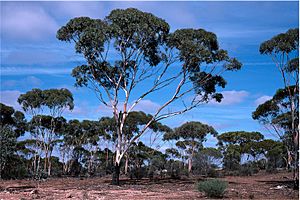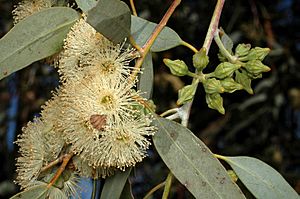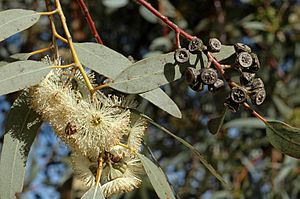Goldfields blackbutt facts for kids
Quick facts for kids Goldfields blackbutt |
|
|---|---|
 |
|
| Eucalyptus lesouefii near Norseman | |
| Scientific classification | |
| Genus: |
Eucalyptus
|
| Species: |
lesouefii
|
The Goldfields blackbutt (scientific name: Eucalyptus lesouefii) is a special type of tree or 'mallet' that grows only in central Western Australia. It's easy to spot because it has rough, black bark near the bottom of its trunk, but smooth bark higher up. Its leaves are shaped like a spear, and its flowers are creamy white. After the flowers, it grows cup-shaped fruits.
Contents
What the Goldfields Blackbutt Looks Like
The Goldfields blackbutt can grow quite tall, usually between 5 and 18 meters (about 16 to 59 feet). Unlike some other eucalyptus trees, it doesn't have a special woody lump called a 'lignotuber' at its base.
Its bark is unique! For about 2 meters (6.5 feet) up from the ground, the bark is rough, flaky, and black. Above that, the bark is smooth and can be brownish, grey, or even coppery. The main trunk is often thick and low, with branches spreading upwards.
Young plants and new shoots have stems that are somewhat square. Their leaves are egg-shaped, about 90-130 mm (3.5-5 inches) long and 45-70 mm (1.7-2.7 inches) wide. These young leaves often have a pale, powdery coating, like a light dust.
Adult leaves are dark green on both sides. They are shaped like a spear or slightly curved, measuring 88-187 mm (3.5-7.3 inches) long and 10-27 mm (0.4-1 inch) wide. Each leaf has a stalk called a petiole, which is 12-25 mm (0.5-1 inch) long.
Flowers and Fruit
The flower buds grow in groups of seven. They are found where the leaves meet the stem. Each group of buds sits on a stalk called a peduncle, which is 8-20 mm (0.3-0.8 inches) long. Each individual bud also has its own small stalk, called a pedicel, 2-8 mm (0.08-0.3 inches) long.
When the buds are ready to open, they look like a pear or a diamond shape. They are 10-22 mm (0.4-0.8 inches) long and 6-12 mm (0.2-0.5 inches) wide. The top part of the bud, which covers the flower, is called an operculum. It's shaped like a beak or is slightly pointed.
Goldfields blackbutt trees usually flower in August, or from October to December, or even from January to February. Their flowers are a pretty creamy white or yellow color.
After flowering, the tree produces woody fruits. These fruits are shaped like a cup or a bell, 6-10 mm (0.2-0.4 inches) long and 8-14 mm (0.3-0.5 inches) wide. They have between ten and twelve deep ridges along their sides.
How the Goldfields Blackbutt Got Its Name
The Goldfields blackbutt was first officially described in 1912 by a botanist named Joseph Maiden. He found a sample of the tree near Kalgoorlie. He wrote about it in his book, A Critical Revision of the Genus Eucalyptus.
The scientific name, lesouefii, was chosen to honor Albert Sherbourne Le Souef. He helped Joseph Maiden with his research.
Where the Goldfields Blackbutt Grows
The Goldfields blackbutt is mostly found in central Western Australia. It grows in areas around Kalgoorlie. You can find it on flat areas, slopes, and places where water collects.
This tree prefers sandy loam soil. Sometimes, it can also grow in clay or gravelly soils.
Uses of the Goldfields Blackbutt
The wood from the Goldfields blackbutt is light brown and very dense. It is useful as firewood because it burns well.
However, these trees can sometimes be affected by termites, also known as white ants. These insects can live inside the trees, which can make the wood less useful.
Images for kids




